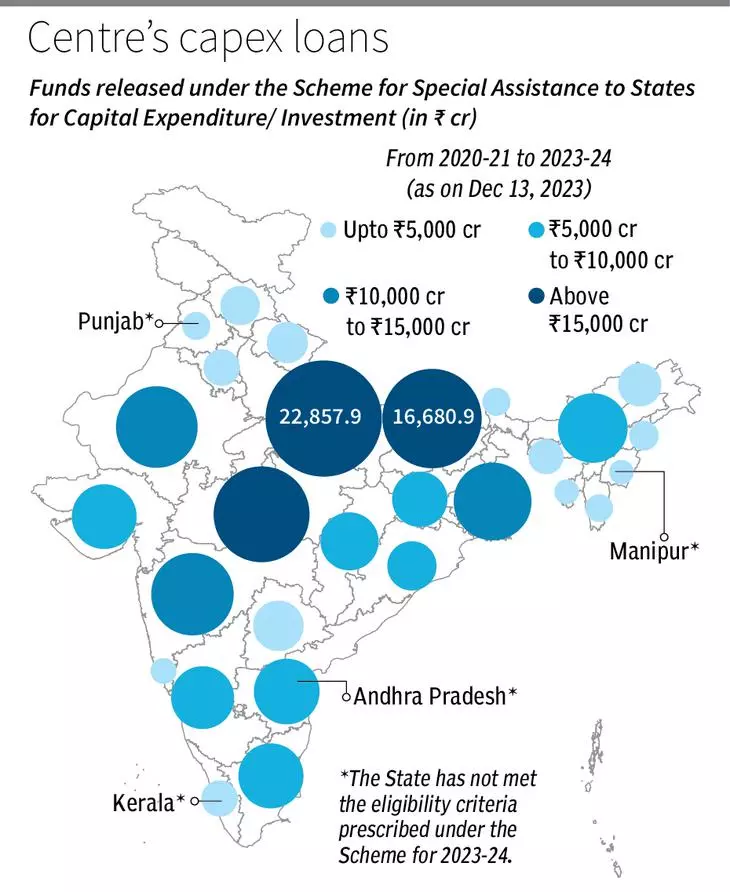Important Facts For Prelims
Scheme for Special Assistance to States for Capital Investment (SASCI)
- 30 May 2025
- 5 min read
Why in News?
The Centre’s 50-year interest-free capex loans under the Scheme for Special Assistance to States for Capital Investment (SASCI) are driving major land reforms across India by pushing states to modernise property systems, boosting efficiency, and industrial growth.
What is SASCI?
- About: The ‘Scheme for Special Assistance to States for Capital Expenditure’ was launched in 2020–21 in response to the Covid-19 pandemic.
- Later renamed as SASCI, it aims to stimulate economic recovery by providing interest-free assistance to states specifically for capital investment.
- Key Features:
- Capital Investment Focus: Provides long term interest free loans for a period of 50 years to states exclusively for capital expenditure projects.
- Capital expenditure boosts productive capacity, creates jobs, and drives sustainable growth. It has a high multiplier effect for every Rs 1 spent it is estimated to generate Rs 3 in Gross Domestic Product (GDP).
- Structure: Divided into multiple parts targeting different sectors, such as urban reforms, vehicle scrapping incentives, police housing, Make in India initiatives, digital infrastructure, Optical Fibre Cable, and tourism development.
- Capital Investment Focus: Provides long term interest free loans for a period of 50 years to states exclusively for capital expenditure projects.
- Progress:
- Massive Scale-Up: The scheme grew from Rs 12,000 crore in 2020-21 to Rs 1,50,000 crore in 2024-25, reflecting increased focus on capital investment.
- Widespread Industrial Reforms: Under SASCI 22 states updated building bylaws for industrial and commercial plots.
- Additionally, 18 states reduced land wastage by optimizing setbacks and parking norms, making more efficient use of available space.
- To support vertical industrial growth, 12 states have doubled the permissible built-up area for flatted factories.
- Furthermore, 8 states have raised the Floor Area Ratio (FAR) in commercial zones, thereby unlocking higher density development and boosting overall urban productivity.
- Rural Land Digitisation: Under SASCI 90% of cadastral maps (land ownership map) geo-referenced nationwide, and 30% of land parcels are assigned Unique Land Parcel Identification Numbers (ULPIN) (Bhu-Aadhar).
- Additionally, 91% of Records of Rights (legal documents containing all necessary information about a land parcel) digitised, enabling transparency and reducing disputes.
- Improved land administration and industrial reforms are expected to increase manufacturing capacity, streamline credit access, and enhance overall economic growth.
- Tourism: For the first time under SASCI, funds have been earmarked for tourism, with Rs 3,295 crore sanctioned for 40 projects across 23 states to develop iconic tourist centres at a global scale.
Capital Expenditure
- Capital Expenditure (Capex) refers to funds spent by the government or businesses on acquiring, upgrading, or maintaining physical assets such as infrastructure, machinery, or technology.
- Unlike Operating Expenses (Opex), which cover day-to-day operational costs, Capex involves substantial long-term investments recorded as assets and depreciated over time.
- The Indian government allocates Capex through its annual Union Budget, with Rs 11.21 lakh crore (3.1% of GDP) earmarked for FY 2025–26.
- Capex as a countercyclical fiscal tool, it stabilizes the economy during downturns and supports future revenue through asset creation.
- Capex also aids in reducing public liabilities via loan repayments and encourages private sector investment, making it essential for India’s sustained development and infrastructure expansion.
UPSC Civil Services Examination, Previous Year Question (PYQ)
Prelims
Q. Which of the following is/are included in the capital budget of the Government of India? (2016)
- Expenditure on acquisition of assets like roads, buildings, machinery, etc.
- Loans received from foreign governments
- Loans and advances granted to the States and Union Territories
Select the correct answer using the code given below:
(a) 1 only
(b) 2 and 3 only
(c) 1 and 3 only
(d) 1, 2 and 3
Ans: (d)







